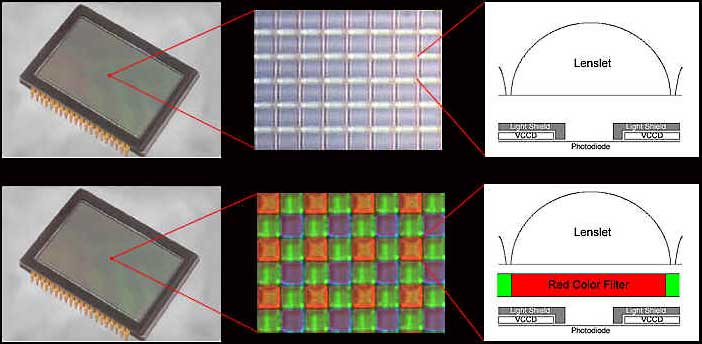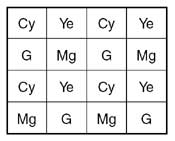
Individual pixels in CCD cameras record only light and dark, black and white. They
don't see color. To produce a color image requires taking three separate monochrome
(black and white) images though individual red, green, and blue filters. These three
black and white images, each representing a single color of light (red, green, or
blue), are then combined in your computer to produce the final full-color image.
Most CCD cameras take the three filtered images sequentially and store them in the
computer for later processing, with the operator changing color filters between
each exposure. However, several CCD manufacturers offer single-shot color cameras
that record all three color images at the same time, in a single exposure. These
cameras are also available in conventional monochrome versions. The single-shot
color CCD cameras are essentially identical to their monochrome counterparts with
the exception of the addition of a permanent color filter matrix over the pixels
that lets them take all three color images simultaneously, as explained below.

The images in the box above show the basic structure of the pixels on a Kodak CCD
detector, such as used on high-end SBIG and Finger Lakes Instrumentation single-shot
color cameras. The top row shows a monochrome detector, the bottom row shows a single-shot
color detector. The center image in each row is an actual photograph of the surface
of the CCD showing a small section of the pixel array. The drawings at the right
depict a side view of an individual pixel.
As you can see from the bottom row of images, the CCD structure for the single-shot
color version is the same as the monochrome version except for the red, green, and
blue pattern of filters over the pixels. The arrangement of colored filters over
the pixels in a single-shot color camera is a repeating square of RGGB known as
a Bayer pattern. This repeating pattern of RGGB pixels allows the separate red,
green and blue data to be collected in a single monochrome exposure and electronically
separated into the three monochrome images your computer needs to reconstruct a
full-color image. Every fourth pixel sees red, every fourth pixel sees blue and
every other pixel sees green. Special software extrapolates the RGB color data for
each individual pixel in the frame from the color information in the adjacent colored
pixels.
Many of the more economical cameras from Celestron, Meade, and Orion use Sony CCD
detectors primarily designed for general use in camcorders and other consumer electronics,
rather than the more-specialized detectors from Kodak. The Sony detectors use a
color filter matrix of yellow, cyan, magenta, and green filters in a repeating sequence
to generate the full color spectrum using sophisticated addition and subtraction
algorithms to generate the desired RBG signal. The Sony filter matrix pattern is
shown below.

What are the differences between taking three separate exposures versus one? Primarily
it is a trade-off between greater complexity, sensitivity, and flexibility at a
higher cost for the monochrome camera versus the single-shot color camera's simplicity,
ease of use, and lower overall cost for color imaging. A single-shot color camera
needs only one image to do the job of the three needed by a monochrome camera/color
filter wheel system. While this is simpler and less time-consuming, it results in
a difference in the amount and quality of data recorded by each camera. The final
image from a single-shot color camera has the same number of total pixels as a color
image created by a monochrome camera and external filters, but it is created from
less original data than the three discrete images of a monochrome camera. In addition,
only one-third of the color information for each pixel is unique to that pixel and
measured directly. The other two color values are approximations, derived from adjacent
pixels.
In the case of a monochrome camera, the external color filters can be designed specifically
for astronomical use, with high light transmission, precisely tailored response
curves, and with better control of the color balance between the emission line and
continuum light for different deep space objects. There is no way to tailor the
sensitivity and spectral response of each color filter in the matrix to match the
emissions of the object you are imaging, or to use special purpose narrowband filters,
such as Oxygen III, SII ionized sulfur, H-alpha, etc. The matrix filters are general
purpose red, green, and blue filters only.
As far as sensitivity is concerned, the monochrome camera is somewhat more sensitive
due mainly to the nature of the external filters compared to the micro-filters placed
over each pixel in the single-shot color camera. The monochrome camera requires
more work to take a tri-color image, however, and the addition of the required filters
and color filter wheel makes it more expensive.
The effective QE (quantum efficiency) of the monochrome camera with external filters
is slightly higher than the single-shot color camera based on the filter transmission
characteristics. But remember, the monochrome camera must take three frames versus
the single-shot color camera's single frame. So for a proper comparison, a monochrome
camera taking a 20 minute image through each of the three filters should be compared
to a single-shot color camera taking a single 60 minute image. In this case, the
single-shot color camera compares very well to its monochrome counterpart. Moreover,
self-guiding the single-shot color camera is easier due to the fact that the separate
built-in guider detector is never covered by a filter which can affect the tracking
performance of the guider. Where a monochrome camera shines is in taking a grayscale
image, or in taking narrow band monochrome or tri-color images of emission line
objects. But for simple color images, single-shot color cameras are very capable.









